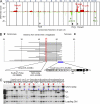ATM-deficient thymic lymphoma is associated with aberrant tcrd rearrangement and gene amplification
- PMID: 20566716
- PMCID: PMC2901073
- DOI: 10.1084/jem.20100285
ATM-deficient thymic lymphoma is associated with aberrant tcrd rearrangement and gene amplification
Abstract
Ataxia telangiectasia mutated (ATM) deficiency predisposes humans and mice to T lineage lymphomas with recurrent chromosome 14 translocations involving the T cell receptor alpha/delta (Tcra/d) locus. Such translocations have been thought to result from aberrant repair of DNA double-strand breaks (DSBs) during Tcra locus V(D)J recombination, and to require the Tcra enhancer (Ealpha) for Tcra rearrangement or expression of the translocated oncogene. We now show that, in addition to the known chromosome 14 translocation, ATM-deficient mouse thymic lymphomas routinely contain a centromeric fragment of chromosome 14 that spans up to the 5' boundary of the Tcra/d locus, at which position a 500-kb or larger region centromeric to Tcra/d is routinely amplified. In addition, they routinely contain a large deletion of the telomeric end of one copy of chromosome 12. In contrast to prior expectations, the recurrent translocations and amplifications involve V(D)J recombination-initiated breaks in the Tcrd locus, as opposed to the Tcra locus, and arise independently of the Ealpha. Overall, our studies reveal previously unexpected mechanisms that contribute to the oncogenic transformation of ATM-deficient T lineage cells.
Figures





References
Publication types
MeSH terms
Substances
Grants and funding
LinkOut - more resources
Full Text Sources
Medical
Molecular Biology Databases
Research Materials
Miscellaneous

